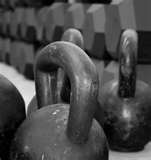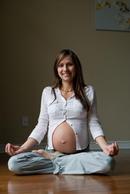Hi all Happy Friday.....
So my last few blogs have been mainly about
nutrition, so this week I decided to switch it up and discuss a topic that you
may have heard about but dont really know what it is or the wonderful benefits
from using it......
KETTLEBELLS.......
So lets see what I'll cover....
What are kettlebells ?
How they are used
Benefits
Technical bits, safety and choosing your Kettlebell
What are Kettlebells?
Kettlebells originate from Russia and are a type of hand weight
that is shaped like a big cannonball with a handle. They are mostly commonly
made out of pure cast iron, and range in weight from 10 pounds, all the way up
to 100 pounds.
They have been around for many centuries. However in the past
decade have really made their way into the fitness industry.
How they are used?
Kettlebells are a multi functional piece of fitness equipment and you need little space to use them. They can be used as traditional weights however, the reason why they are so popular is that they are great for shaping, burning fat and building the posterior chain through a variety of swinging and snatching movements.
They are unique due to their shape and distribution of mass which
allows you to move it freely and it allows you to keep your hand and wrists in
neutral alignment, which is difficult with traditional weights. This in turn
will improve endurance and promote and longevity in the core lifts (swings,
clean and press, snatches) enabling and enhancing fitness
Benefits
Kettlebell training has many benefits to offer those who use it
on a regular basis. These benefits include:
Improved Endurance
Total body strengthning
Increased flexibility
Decrease in fat levels
Little speace required to train
Can prevent for help back pain
Helps build the posterior chain muscles
You might be asking, what exactly is the posterior chain?
Its one of the most important sets of muscles you have. They include lowerback, the glutes, the hamstrings, and also the calves. Unfortunately the Posterior Chain is all to often neglected, why? Well because we don't see them, and a huge percentage of the population often live sedentary lifestyles. A weak posterior chain can lead to various aches and pains plus a poor posture. Once you start strengthening the Posterior Chain you can expect to eliminate any lower back pain and have better posture.
Technical bits, safety and choosing your Kettlebell
When choosing your Kettlebell you will need to know a few things about how a Kettlebell is used, it is best to speak to a qualified person regarding which weight and style is the best. The Kettlbell is a versatile piece of equipment and there are alot of good and bad models on the market.
As I mentioned there are many brands on the market all different materials. I
recommend all clients to opt for the cast iron ones and when they are testing
them make sure that they can slide their hand through the handle portion of the bell as this will enable proper movement of the bell when carrying out lifts
such as snatches etc.
For me I have been using kettlebeels now for almost three years. I
have used them in my training and trained clients as well. For me I seen the
benefits in shoulder strength and glute, hamstring and erector spinae
development.
When I use them with clients especially here I have seen clients come who could not press 4kg to being able to snatch 12KG..... also the benefits for fat loss and also they are fun :)... But all in all the results were remarkable.....
I hope that this article was of interest. If you have any questions please drop me a line.
Until next week
Keep healthy
Jxx
So my last few blogs have been mainly about
nutrition, so this week I decided to switch it up and discuss a topic that you
may have heard about but dont really know what it is or the wonderful benefits
from using it......
KETTLEBELLS.......
So lets see what I'll cover....
What are kettlebells ?
How they are used
Benefits
Technical bits, safety and choosing your Kettlebell
What are Kettlebells?
Kettlebells originate from Russia and are a type of hand weight
that is shaped like a big cannonball with a handle. They are mostly commonly
made out of pure cast iron, and range in weight from 10 pounds, all the way up
to 100 pounds.
They have been around for many centuries. However in the past
decade have really made their way into the fitness industry.
How they are used?
Kettlebells are a multi functional piece of fitness equipment and you need little space to use them. They can be used as traditional weights however, the reason why they are so popular is that they are great for shaping, burning fat and building the posterior chain through a variety of swinging and snatching movements.
They are unique due to their shape and distribution of mass which
allows you to move it freely and it allows you to keep your hand and wrists in
neutral alignment, which is difficult with traditional weights. This in turn
will improve endurance and promote and longevity in the core lifts (swings,
clean and press, snatches) enabling and enhancing fitness
Benefits
Kettlebell training has many benefits to offer those who use it
on a regular basis. These benefits include:
Improved Endurance
Total body strengthning
Increased flexibility
Decrease in fat levels
Little speace required to train
Can prevent for help back pain
Helps build the posterior chain muscles
You might be asking, what exactly is the posterior chain?
Its one of the most important sets of muscles you have. They include lowerback, the glutes, the hamstrings, and also the calves. Unfortunately the Posterior Chain is all to often neglected, why? Well because we don't see them, and a huge percentage of the population often live sedentary lifestyles. A weak posterior chain can lead to various aches and pains plus a poor posture. Once you start strengthening the Posterior Chain you can expect to eliminate any lower back pain and have better posture.
Technical bits, safety and choosing your Kettlebell
When choosing your Kettlebell you will need to know a few things about how a Kettlebell is used, it is best to speak to a qualified person regarding which weight and style is the best. The Kettlbell is a versatile piece of equipment and there are alot of good and bad models on the market.
As I mentioned there are many brands on the market all different materials. I
recommend all clients to opt for the cast iron ones and when they are testing
them make sure that they can slide their hand through the handle portion of the bell as this will enable proper movement of the bell when carrying out lifts
such as snatches etc.
For me I have been using kettlebeels now for almost three years. I
have used them in my training and trained clients as well. For me I seen the
benefits in shoulder strength and glute, hamstring and erector spinae
development.
When I use them with clients especially here I have seen clients come who could not press 4kg to being able to snatch 12KG..... also the benefits for fat loss and also they are fun :)... But all in all the results were remarkable.....
I hope that this article was of interest. If you have any questions please drop me a line.
Until next week
Keep healthy
Jxx


 RSS Feed
RSS Feed